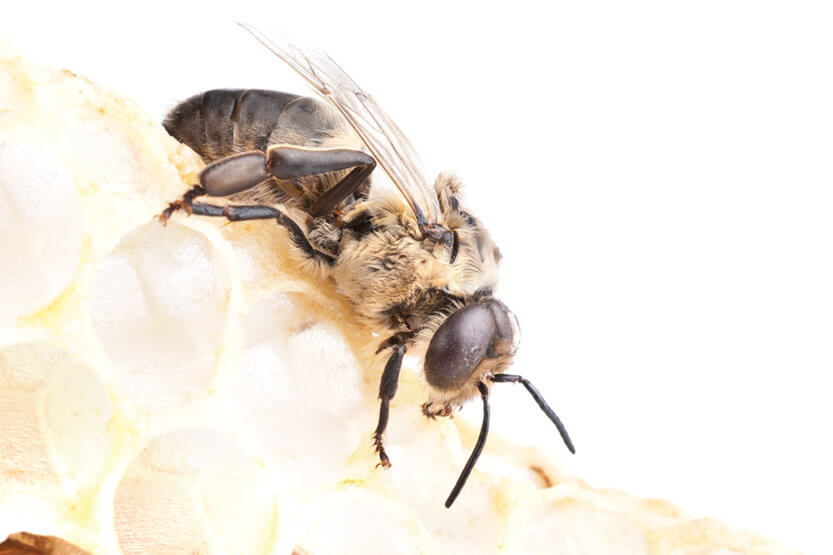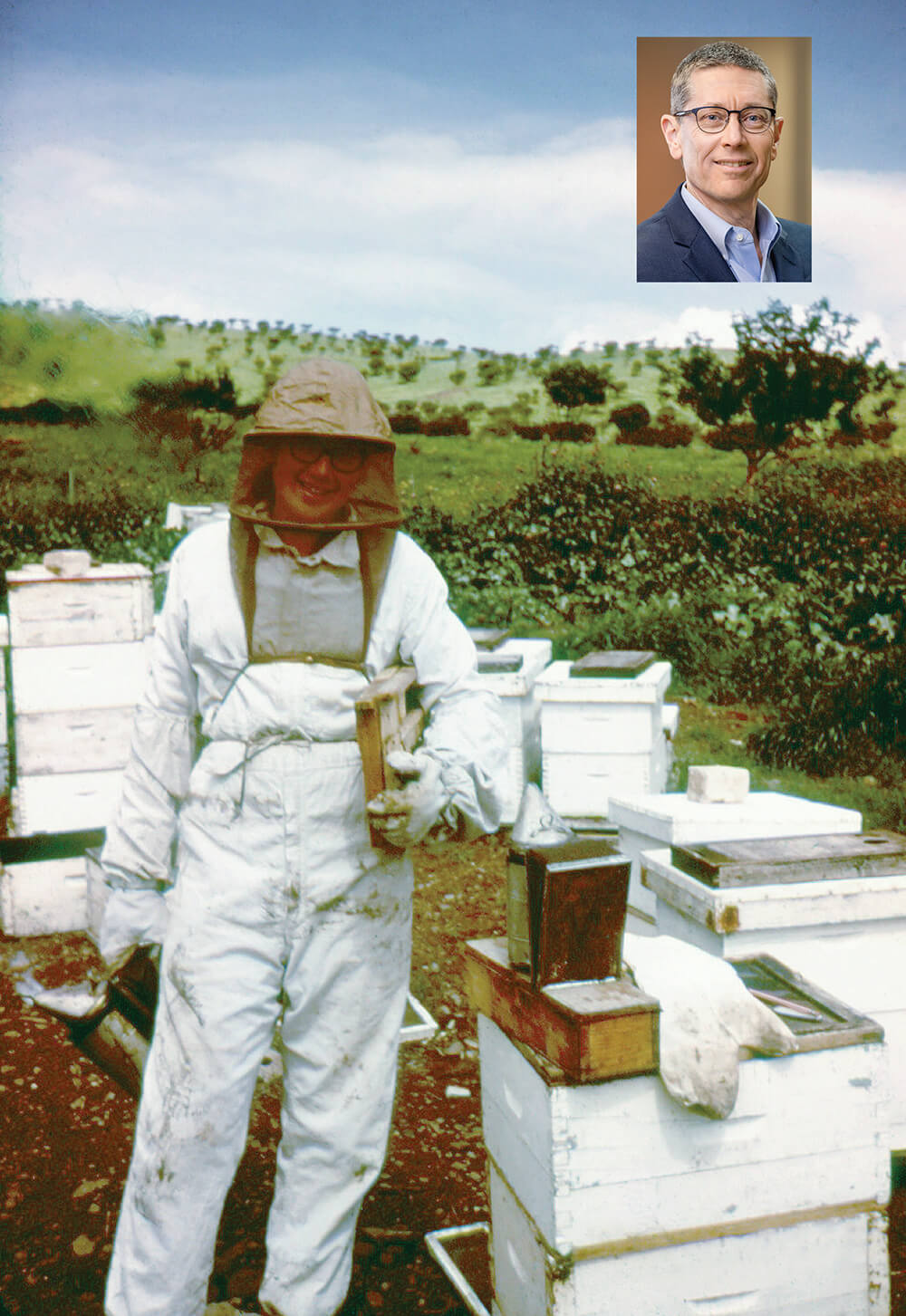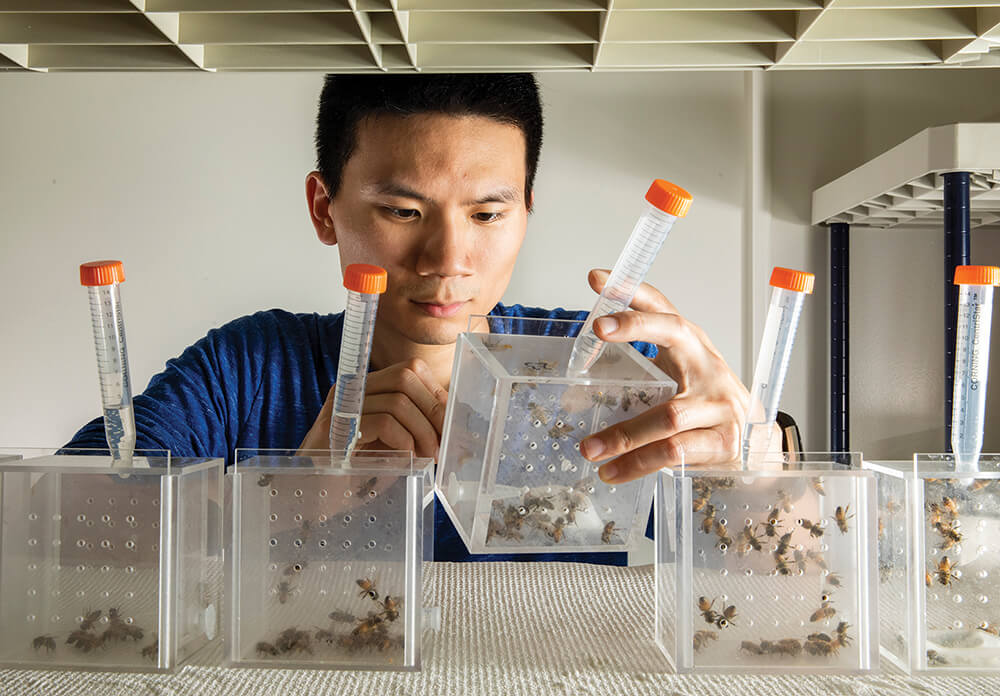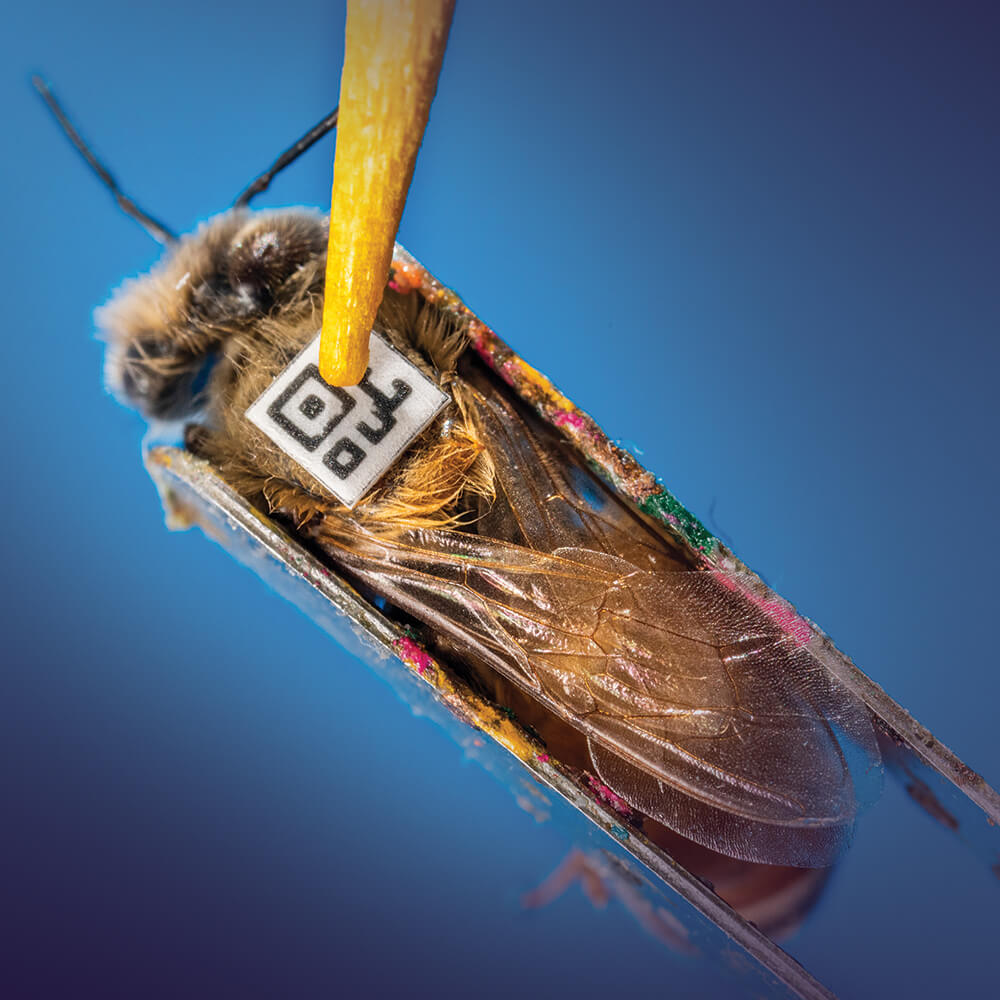Gene and the honey bee
 “Against all odds, the honey bee was among the first six non-human species selected by the NIH for sequencing,” Berenbaum says. “To put this in perspective, the honey bee genome scored a higher priority than the cow, the chicken and the chimpanzee, any of which would seem to have been an easier sell than honey bees, given that we don’t milk them, fry them or claim them as our closest relatives.” (Image by Roman Pyshchyk/123RF)
“Against all odds, the honey bee was among the first six non-human species selected by the NIH for sequencing,” Berenbaum says. “To put this in perspective, the honey bee genome scored a higher priority than the cow, the chicken and the chimpanzee, any of which would seem to have been an easier sell than honey bees, given that we don’t milk them, fry them or claim them as our closest relatives.” (Image by Roman Pyshchyk/123RF) For anyone trying to tease out how the brain makes sense of the world, the honey bee is a perfect study organism. It’s a social animal, living in a complex society where the jobs are divvied up. It has its own special language, the waggle dance, that scout bees use to tell their nestmates exactly where to find the best flowers.
The honey bee also is a champion navigator, using the sun and other cues to find its way to floral resources sometimes miles away and then bring them back to the hive. It harvests and then processes—some would say “cooks”—its food.
It’s an engineer, building an elaborate, sturdy home for itself with plenty of nursery and storage space. It also undergoes developmental changes over the course of its brief lifetime, taking on new jobs in response to its own internal cues or the hive’s shifting needs.
As Illinois Professor of Entomology Gene Robinson has shown, this is only the beginning of what makes the honey bee a beguiling study subject. Robinson—who holds a Swanlund Chair, directs the Carl R. Woese Institute for Genomic Biology, and now serves as the interim dean designate of the College of Liberal Arts and Sciences—got his start with the honey bee well before genomics existed as a field. Genomics is the study of how an organism’s entire genetic endowment functions and—we now know, thanks to scientists such as Robinson—responds to environmental cues.
A solid bee student
Robinson first encountered honey bees during a 10-month stint in Israel at a kibbutz, a communal settlement often devoted to agricultural pursuits. He was 18 years old, taking a break from college to figure things out. He had been picking grapefruits, but the beekeeper needed a hand and, eager for a change of pace, Robinson volunteered. That happenstance was fortunate for Robinson—and for honey bees.
“I set out to make myself indispensable to the beekeeper so that he would keep me on,” Robinson says. “I read everything I could on bees, took extensive notes, asked lots of questions and met with him regularly after work. I was driven, even though I didn’t know what I was driving to.”
Robinson had found his calling. He knew he wanted to work with bees. Thanks to his mother’s persistent advice that he get a Ph.D. in entomology, he also found the way to do it.

Entomologist Gene Robinson’s interest in honey bees began while helping out a beekeeper on a kibbutz in Israel during 1984. “I set out to make myself indispensable to the beekeeper so that he would keep me on,” he says. “I read everything I could on bees, took extensive notes, asked lots of questions.” (Image courtesy of Gene Robinson; (Inset) L. Brian Stauffer/UI Public Affairs)
Robinson’s studious pursuit of the honey bee has yielded many scientific riches, documented in more than 300 published scientific papers. Most of this work stems from an insight Robinson had relatively early in his career, at the moment the genomics revolution was just gearing up. He realized that the honey bee would be an ideal model for studies of social behavior, communication, altruism and developmental changes throughout the lifespan. But conducting that research without the honey bee genome would be laborious, slow and likely inaccurate. The researchers needed the genome. His instinct was right. His findings have since changed scientists’ basic understanding of how molecular biology allows the brain—in both honey bees and humans—to make sense of the world and to respond.
“In 1997, after reading about the relatively new science of genomics, Gene realized the power of an approach that could allow him to examine all bee genes at once rather than one at a time,” says May Berenbaum, entomology professor and department head who was involved in the effort to recruit Robinson to campus. By 2001, Robinson organized scientists and the bee community (a community not necessarily known for “playing well” together, Berenbaum notes) to build momentum for a broad-scale, international effort to sequence the honey bee genome.
Their ultimate proposal to the National Human Genome Research Institute in 2001 came at a time when only a few species had their genomes sequenced. The first to receive this honor were bacteria and yeast, as well as a worm and fruit fly that were widely used in scientific studies. That same year, the first draft of the human genome sequence was released.
“Against all odds, the honey bee was among the first six non-human species selected by the NIH for sequencing,” Berenbaum says. “To put this in perspective, the honey bee genome scored a higher priority than the cow, the chicken and the chimpanzee, any of which would seem to have been an easier sell than honey bees, given that we don’t milk them, fry them or claim them as our closest relatives.”
This feat was largely the result of Robinson’s passion for the honey bee, along with his ability to bring teams of people together, Berenbaum says. “He embodies the virtues people have admired unscientifically in bees for centuries: their industriousness, their cooperative nature, their perceptiveness and their ability to accomplish amazing things.”
Hive Minded
Robinson has a way of bringing other scientists into his work that advances and enriches their own careers. For example, Berenbaum—who studies how insects detoxify plant-defensive chemicals—went to him for help when she wanted to look at the antioxidant characteristics of various monofloral honeys.
“He’s about brains; I’m about stomachs and eating,” Berenbaum says. “And bees are insects that feed on plants.” Together they discovered that honeys from different floral sources varied greatly in their antioxidant capacities.
When Robinson was lining up collaborators to work on the honey bee genome, he invited Berenbaum to annotate one set of genes associated with chemical detoxification.
“I had to unlearn everything I knew about insects to study honey bees, because they’re not like other insects,” Berenbaum says. “Gene knew that all along, but I had to kind of learn it the hard way. It was his generosity—sharing the tools, sharing the expertise, sharing the bee facility—that made my work with bees possible.”
“Gene was very gracious to me,” says Alison Bell, a professor of evolution, ecology and behavior who came to Illinois in 2006. “He was an unofficial mentor to me when I first arrived. He read my grant proposals and gave me career advice. He invited me to write a perspective piece with him in Science.”
Bell describes Robinson as the quintessential professional, noting that while he cuts to the chase and keeps to a tight schedule, he is extremely generous with his time. “He is very, very gracious. He’s extremely welcoming. And he is charming.”
Claudia Lutz, PHD ’12 LAS, worked in Robinson’s lab and remembers her first meeting with him. She traveled directly to campus from the airport, and she was nervous.
“I remember that part way through the meeting, his phone started ringing. And he said, ‘I only answer the phone in the middle of a meeting if it’s my family.’ And he disregarded the call and continued to talk to me for the rest of the hour that we had scheduled,” she says. “That impressed me.” (Robinson’s son Sol, ’17 ENG, interned with U of I’s National Center for Supercomputing Applications and worked with Microsoft’s Xbox team.)
Robinson’s driving interest in the honey bee—in particular, its devotion to the hive even at its own expense—is not an accident.
“The personal and the professional intersect in Gene. He’s fascinated by altruism,” Berenbaum says. “His driving question is ‘What flips a ‘me’ gene into a ‘we’ gene?’ That’s how he puts it.”
But the questions honey bees are helping answer go well beyond their contribution to understanding collective behavior or the power of altruism. They also are instructive in efforts to understand how variations among individuals contribute to the resilience of the collective.
Nature and nurture
Scientific thinking about how the brain functions—and about whether personality is shaped primarily by nature (inheritance) or nurture (the environment)—has changed so dramatically over the decades that it can be difficult to reconstruct what researchers previously thought.
There was a time when people believed that social insects such as ants and honey bees were more like “little robots” than dynamic, living organisms, Robinson says. Many also thought that individual human personalities and capabilities were simply the byproducts of their genetic inheritance or, conversely, that all humans were essentially “blank slates” at birth, ready to be written upon by experience.
Robinson’s work with honey bees has revealed the underlying molecular biology that links nature and nurture. His research shows that while the brain may be hard-wired for some essential functions, it also is malleable, profoundly shaped by experience. With painstaking care, Robinson and others have forged a new field, sociogenomics, that uses a data-driven approach to explain the step-by-step mechanisms that allow the brain to respond to environmental, developmental and social experience.

Robinson conducts much of his groundbreaking honey bee work at the University’s Bee Research Facility, where researchers currently are studying how gene activity interacts with neurons in the brain to regulate behavior, as well as exploring the evolution of gentleness in a population of otherwise notoriously aggressive bees. (Image by Fred Zwicky/UI Public Affairs)
Robinson says he is “acutely aware of how genetic analyses of behavior can be misused to justify genocide and systemic racism.” As a child of Holocaust survivors, he recognizes that “behavioral genetics has a legacy of shame.” His work, along with similar work conducted in other labs with other organisms, has slowly dismantled the rotting foundations on which those earlier ideas were built.
The honey bee—and the relatively new science of genomics—allowed Robinson and his peers to develop a clearer view of actual brain mechanisms and to steer the debate away from the biased assumptions that once dominated the field of behavioral genetics.
Perhaps the most striking early discovery from Robinson’s lab—and there were many—involved a new technology that revealed which genes in the brain were being turned up or turned down in response to an event or experience.
By exposing bee DNA to activity-dependent dyes in a series of glass wells, called microarrays, Robinson and his colleagues could analyze thousands of genes at a time to see whether any were being turned into the blueprints for specific proteins at higher or lower rates after an environmental or social cue.
Their study, published in the journal Science in 2003, revealed that thousands of genes were expressed differently in honey bees that worked as nurse bees compared to those making the transition to become foragers. This process, Robinson earlier showed, was driven by the bees’ perception of a pheromone that reflects the needs of their colony.
“This was the first genomic paper showing how the social environment massively influences brain gene expression, the first such finding in any organism,” Robinson says. “We also found that there was a surprisingly close relationship between brain gene expression and behavior, such that a computer could predict whether bees were nurses or foragers based on the gene expression pattern alone.”
This was a huge advance in understanding how experience gets into the brain. It showed that gene expression is flexible and responsive to social events. This was a key that could help decipher the nature/nurture puzzle.
“His work has shown that gene activity in the brain reflects the interaction between hereditary and environmental information,” Berenbaum says.
Easing the Sting
Robinson’s work also has played an important role in the effort to understand new threats to the honey bee. He and his colleagues across the world published the honey bee genome in late 2006, just as the first reports of a mysterious malady of honey bees started to emerge. Honey bees were disappearing from their hives, a phenomenon eventually dubbed “colony collapse disorder.” Beekeepers, scientists and agricultural experts were stumped.
The honey bee genome was essential to trying to tease out what was going on. It advanced the science, ultimately leading to a new understanding of the factors—primarily pathogens, pesticides, parasites and poor nutrition—that were undermining honey bee health.Those who study honey bee health call these “the four Ps.”
“Another way of looking at the four Ps is stress,” Robinson says. “In the case of bees, the degradation of their health has to do with fewer flowers. Landscapes now contain fewer flowers. Agriculture is more productive, but a tradeoff is a decrease in weeds. Some plants that are weeds to farmers are nectar plants for bees. And so, the loss of flowers has created nutritional stress for bees in general, putting them on the edge for other kinds of stressors.”
Robinson may be the first person elected to the National Academy of Medicine to also receive the prestigious Wolf Prize in Agriculture. Both of these honors came to him in 2018. He was elected to the National Academy of Sciences in 2005.
“Possibly even more impressive than being elected to NAS and NAM was also winning the Wolf Prize in Agriculture,” Berenbaum told a group of colleagues who gathered at the IGB to honor Robinson. “Ever since 1981, when he published his first paper on honey bees, Gene has been able to see the value of the honey bee, not just as a servant of humans as a pollinator and honey-maker, but as a model for humans.”
Sweet as Honey
Robinson and the honey bee are continuing their long-term relationship, to the benefit of behavioral science, neuroscience and other fields. Through current projects, he and his colleagues are studying how gene activity interacts with the activity of neurons in the brain to regulate behavior, as well as exploring the evolution of gentleness in a unique population of otherwise notoriously aggressive Africanized bees. His lab also has developed a way to automatically monitor colonies using barcodes attached to individual bees and is studying how the bees’ social networks influence their resilience and division of labor.
Robinson came to the University because it had “a great reputation for entomology.” He soon discovered that east central Illinois also is a good place for honey bees. “Bees do well here, and that’s made it easier to do my work,” he says.
He stayed here because U of I actively promotes a collaborative culture and because campus leaders recognized the value of his vision and supported his work, even when he was just starting out. And now, as director of a research institute devoted to harnessing the power of genomics, Robinson has found his niche. It’s a position from which he can build and support a community of industrious collaborators tackling essential questions using the best tools and strategies available. Sound familiar?
This article first ran in Storied, August 2019, and is used with permission.

Robinson’s lab uses matrix barcodes attached to individual bees to automatically monitor colonies. (Image by Fred Zwicky/UI Public Affairs)
The buzz on honey bees
Here are some key findings from the Robinson lab
- Scout bees—the ones that go out to find new floral resources—have different brain gene expression profiles than other foragers who are less adventurous and rely on the scouts to direct their foraging. The scout profile contains genes that have been associated with novelty-seeking in humans.
- Despite their genetic similarity to one another, honey bees have individual personalities. For example, some foraging bees are novelty seekers, traveling far and wide in search of nectar and pollen. Others are less adventurous and stay closer to home.
- Some bees display behavioral traits and genetic profiles that are reminiscent of autism in humans.
- Together with other IGB scientists, Robinson discovered that honey bees, mice and stickleback fish share many genes in the brain that serve the same, or very similar, behavioral functions. This suggests that evolution provided organisms across the tree of life with a common kit of molecular tools that have been used to accomplish similar tasks in sometimes wildly different circumstances.
- Honey bees that have been exposed to cocaine tend to dance more, exaggerating (through their “waggle dance”) the value of resources they find outside the hive. Robinson says this shows how the brain’s reward system can be rewired to support cooperative behavior.

